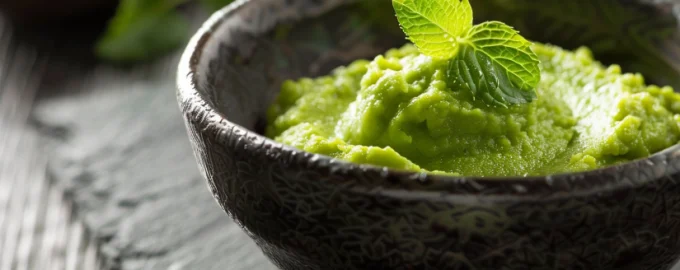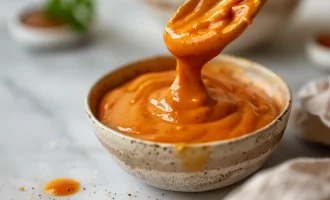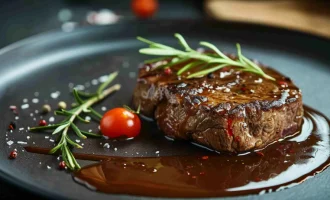Wasabi sauce, deriving from the pungent and revered wasabi root, holds a special place in Japanese cuisine’s heart. Wasabi, known scientifically as Wasabia japonica, is a member of the Brassicaceae family, which includes cabbages, horseradish, and mustard. Its history in Japan dates back to the 10th century, used not only for its flavor but also for its supposed medicinal properties, including being a natural antimicrobial agent for raw fish dishes. Traditionally, wasabi is served with sushi and sashimi, but the creamy wasabi sauce variation has gained popularity for its versatility, adding a spicy kick to sushi rolls, salads, and even as a condiment for steak or sandwiches.
- Wasabi powder 30 g
- Mayonnaise 100 g
- Soy sauce 1 tablespoon
- Lemon juice 1 tablespoon
- Sugar 1 teaspoon
- In a small bowl, mix the wasabi powder with 3 tablespoons (45ml) of water. Stir until it forms a thick paste. Let it sit for 5 minutes to develop its flavor.
- In another bowl, combine the rehydrated wasabi paste with mayonnaise, soy sauce, lemon juice, and sugar. Mix well until the sauce is smooth and uniform in color.
- Taste the sauce and adjust the ingredients as needed. If you prefer a thinner sauce, you can add a little more lemon juice or water.
- Your wasabi sauce is now ready to be served with sushi rolls, sashimi, or your favorite dishes that need a spicy kick.
Storage Tips
Wasabi sauce can be stored in an airtight container in the refrigerator for up to a week. Its flavor might intensify over time, so it’s a good idea to taste it before serving again.
Useful Properties of Wasabi
Wasabi is known for its health benefits, including anti-inflammatory properties and the potential to reduce the risk of certain cancers. The compounds that give wasabi its fiery kick can also help fight foodborne bacteria, making it an excellent companion to raw fish dishes.
Interesting Facts
- Real vs. Fake Wasabi: Most wasabi served outside Japan is actually horseradish dyed green, as true wasabi is rare and expensive due to its difficult cultivation process.
- Culinary Uses: Beyond sushi, wasabi sauce has found its way into Western cuisine, used in sandwiches, burgers, and even as a flavoring for snacks.
Here’s the image of the wasabi sauce as described, showcasing its creamy texture and the vibrant color that hints at its spicy flavor. This visual complements the recipe, inviting you to try making this versatile sauce at home.







